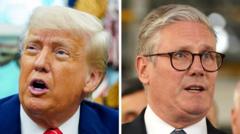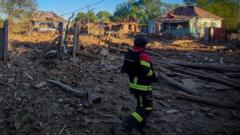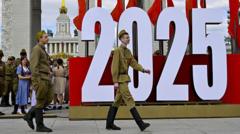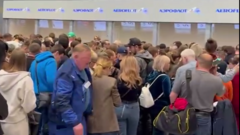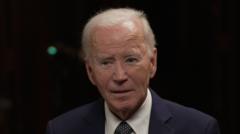Diplomats are grappling with significant hurdles, including conflicting demands and a lack of clarity on future agreements.
US Pushes for Diplomatic Resolution to Ukraine Conflict, But Uncertainty Lingers
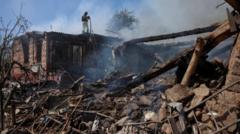
US Pushes for Diplomatic Resolution to Ukraine Conflict, But Uncertainty Lingers
Despite intensified negotiations among key players, the outcome of US-led efforts to end the Ukraine war remains uncertain.
The pace of diplomatic negotiations toward resolving the Ukraine crisis is accelerating, with discussions occurring in London among representatives from the UK, Germany, France, Ukraine, and the US. Notably, special envoy Steve Witkoff is en route to Moscow for his fourth dialogue with President Putin. However, the ultimate destination of these talks appears ambiguous, raising questions about potential success.
Earlier, the US had a straightforward plan calling for an immediate, unconditional 30-day ceasefire followed by longer negotiations for a permanent solution. Ukraine agreed to this and, under US encouragement, compromised on its demand for long-term security guarantees before a ceasefire could commence. Yet, Russia dismissed the proposal, asserting that it would only consider a halt to hostilities if various preconditions were met. Among these, Putin emphasized the need to address the war's underlying reasons, including NATO's expansion and Ukraine's status as a sovereign nation, which Russia contends poses a security risk.
Currently, the US is exploring a ceasefire proposal with several contentious aspects reported through various leaks. This framework may entail Russia ceasing its advances and relinquishing aspirations of controlling remaining territories in eastern Ukraine, including Luhansk, Donetsk, Zaporizhzhia, and Kherson. In return, the US could acknowledge these regions as de facto Russian territory and ultimately recognize Crimea, annexed by Russia in 2014, as part of Russia. Furthermore, it may involve the stipulation that Ukraine would formally refrain from joining NATO, alongside potential US control of the Zaporizhzhia nuclear power plant, with electricity supplied to both Ukrainian regions.
However, skepticism surrounds the proposal's viability. President Zelensky's firm stance against conceding Crimea remains a significant barrier. Moreover, obtaining public support through a referendum would be a prerequisite for any such shift. European nations have also voiced opposition to recognizing Crimea as Russian territory, considering it a violation of international legal norms established post-war.
Legal experts point out additional complications regarding US recognition of Crimea due to existing congressional legislation. Despite these challenges, some western diplomats have noted the possibility of compromise, implying there may be "a landing space" for agreement if mutual trust can be established.
Concerns over major gaps in the proposed deal linger. Notably, there are no specifications regarding a prohibition on western nations continuing to arm Ukraine—an issue that has been a firm red line for Russia. The absence of commitments related to the demilitarization of Ukraine's military—another significant demand from Moscow—further complicates negotiations. While Ukraine may forego NATO membership, it could pursue European Union accession without opposition to a potential European reassurance force in western Ukraine post-ceasefire.
Additionally, the timeline and conditions regarding lifting economic sanctions against Russia remain uncertain, leaving numerous details unresolved. Currently, parties appear to diverge significantly in their positions: Ukraine seeks a conditional ceasefire followed by discussion, the US looks for a swift resolution, while Russia requests thorough negotiations on a peace deal—an undertaking that could take extended periods to finalize.
In the words of an old Russian adage, "nothing is agreed until everything is agreed," and currently, an agreement seems distant.
Earlier, the US had a straightforward plan calling for an immediate, unconditional 30-day ceasefire followed by longer negotiations for a permanent solution. Ukraine agreed to this and, under US encouragement, compromised on its demand for long-term security guarantees before a ceasefire could commence. Yet, Russia dismissed the proposal, asserting that it would only consider a halt to hostilities if various preconditions were met. Among these, Putin emphasized the need to address the war's underlying reasons, including NATO's expansion and Ukraine's status as a sovereign nation, which Russia contends poses a security risk.
Currently, the US is exploring a ceasefire proposal with several contentious aspects reported through various leaks. This framework may entail Russia ceasing its advances and relinquishing aspirations of controlling remaining territories in eastern Ukraine, including Luhansk, Donetsk, Zaporizhzhia, and Kherson. In return, the US could acknowledge these regions as de facto Russian territory and ultimately recognize Crimea, annexed by Russia in 2014, as part of Russia. Furthermore, it may involve the stipulation that Ukraine would formally refrain from joining NATO, alongside potential US control of the Zaporizhzhia nuclear power plant, with electricity supplied to both Ukrainian regions.
However, skepticism surrounds the proposal's viability. President Zelensky's firm stance against conceding Crimea remains a significant barrier. Moreover, obtaining public support through a referendum would be a prerequisite for any such shift. European nations have also voiced opposition to recognizing Crimea as Russian territory, considering it a violation of international legal norms established post-war.
Legal experts point out additional complications regarding US recognition of Crimea due to existing congressional legislation. Despite these challenges, some western diplomats have noted the possibility of compromise, implying there may be "a landing space" for agreement if mutual trust can be established.
Concerns over major gaps in the proposed deal linger. Notably, there are no specifications regarding a prohibition on western nations continuing to arm Ukraine—an issue that has been a firm red line for Russia. The absence of commitments related to the demilitarization of Ukraine's military—another significant demand from Moscow—further complicates negotiations. While Ukraine may forego NATO membership, it could pursue European Union accession without opposition to a potential European reassurance force in western Ukraine post-ceasefire.
Additionally, the timeline and conditions regarding lifting economic sanctions against Russia remain uncertain, leaving numerous details unresolved. Currently, parties appear to diverge significantly in their positions: Ukraine seeks a conditional ceasefire followed by discussion, the US looks for a swift resolution, while Russia requests thorough negotiations on a peace deal—an undertaking that could take extended periods to finalize.
In the words of an old Russian adage, "nothing is agreed until everything is agreed," and currently, an agreement seems distant.




